The sea dragons bounce back
The evolution of ichthyosaurs, important marine predators of the age of dinosaurs, was hit hard by a mass extinction event 201 million years ago, according to a study from the University of Bristol.
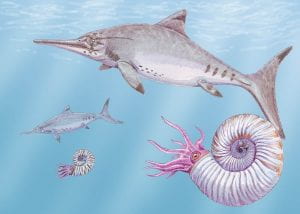 Ichthyosaurs are iconic fossils, generally dolphin-shaped (image right, top), and feeding on a diet of fishes and marine molluscs including belemnites and ammonites (image right, bottom). Ichthyosaurs were first discovered 200 years ago by Mary Anning on the Jurassic coast of Dorset at Lyme Regis. Hundreds of specimens of these dolphin-shaped predators have since been found, and they were abundant and important predators in Jurassic seas. The study shows, however, that Mary Anning’s Jurassic ichthyosaurs were actually a much reduced remnant of the former glory of the group.
Ichthyosaurs are iconic fossils, generally dolphin-shaped (image right, top), and feeding on a diet of fishes and marine molluscs including belemnites and ammonites (image right, bottom). Ichthyosaurs were first discovered 200 years ago by Mary Anning on the Jurassic coast of Dorset at Lyme Regis. Hundreds of specimens of these dolphin-shaped predators have since been found, and they were abundant and important predators in Jurassic seas. The study shows, however, that Mary Anning’s Jurassic ichthyosaurs were actually a much reduced remnant of the former glory of the group.
Ichthyosaurs originated in the Early Triassic, 250 million years ago, and during the Triassic they became hugely varied in adaptations. Triassic ichthyosaurs ranged in length from 0.3 to 20 m, and in shape from long and slender to deep-bodied. The giant shonisaurids of the Late Triassic were whale-sized, 20 m (60 feet) long and may have fed on shoals of squid by gulping them down with their massive mouths. Ichthyosaurs were diapsid reptiles, perhaps distantly related to modern lizards, and they were supremely adapted to marine life, swimming with lateral undulations of the tail and steering with elongate fore paddles, and producing live young at sea. In their way then ichthyosaurs replicated many of the modes of life seen among modern dolphins and whales.
The high diversity and broad ecological range of ichthyosaurs came to an abrupt halt at the end of the Triassic, 200 million years ago, when a mass extinction devastated life on land and in the oceans. This crisis was caused by massive volcanic eruptions as the Atlantic Ocean began to open up between Europe and North America. The volcanic gases caused flash heating and loss of oxygen in the oceans.
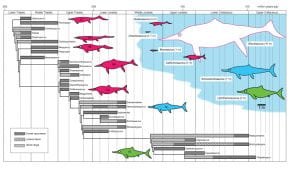
Figure 1 (above). Chart showing the evolution of ichthyosaurs, and the effects of the end-Triassic mass extinction. Geological time runs from left to right, showing known ranges (dark grey), ghost ranges (minimal implied phylogenetic gap; light grey), and Lazarus ranges (missing within-range representation; diagonal bars). Silhouette outlines (Ca., Californosaurus; Ch., Chaohusaurus; Mi., Mixosaurus; Pl., Platypterygius; Sh, Shonisaurus; Te, Temnodontosaurus; Ut., Utatsusaurus) indicate major body morphologies in Triassic (red), Early Jurassic (blue), and Middle Jurassic-Cretaceous (green). Relative sizes of the various major ichthyosaur morphotypes are indicated by scale drawings at top right, with a 1-m scale bar indicated in the blue cloud. Full details in Thorne et al. (2011).
It had always been known that only three or four species of ichthyosaurs survived this devastating event, but everyone had assumed that the ichthyosaurs bounced back successfully to recreate their former important position in marine ecosystems.
The end-Triassic bottleneck
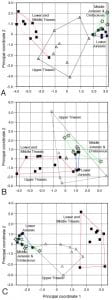 Figure 2 (left). Morphospace occupation by ichthyosaurs. Plots are based on the first two axes from the principal coordinates analysis for each data set: A, whole body characters; B, cranial characters; C, postcranial characters. Taxa from the four time bins are distinguished by symbols, and minimal morphospace occupations by ichthyosaurs of each time bin are indicated by polygon outlines, differently colored for each time bin (red, Early-Middle Triassic; black, Late Triassic; blue, Early Jurassic; green, Middle Jurassic-Cretaceous). Full details in Thorne et al. (2011).
Figure 2 (left). Morphospace occupation by ichthyosaurs. Plots are based on the first two axes from the principal coordinates analysis for each data set: A, whole body characters; B, cranial characters; C, postcranial characters. Taxa from the four time bins are distinguished by symbols, and minimal morphospace occupations by ichthyosaurs of each time bin are indicated by polygon outlines, differently colored for each time bin (red, Early-Middle Triassic; black, Late Triassic; blue, Early Jurassic; green, Middle Jurassic-Cretaceous). Full details in Thorne et al. (2011).
However, the Bristol research indicates that this was not the case. Using numerical techniques, the researchers explored the range of adaptations seen in ichthyosaurs from the Triassic (252-201 million years ago), and Jurassic (201-145 million years ago). They found that, while there were as many species present in the Jurassic as in the Triassic, their range of shapes and sizes was only about one-tenth of what it had formerly been.The research was carried out by Philippa Thorne as part of her work towards the Masters in Palaeobiology degree, which she received in February 2011. Philippa worked in collaboration with Dr Marcello Ruta and Professor Michael Benton, both in the School of Earth Sciences at the University of Bristol.
“We applied a set of demanding numerical approaches to a data set that contained character codings for all major Triassic and Jurassic ichthyosaurs,” said Philippa. “These methods allow us to explore rates of overall character change through time, and to compare the amount of variation in all aspects of the body shape and adaptations of different groups and different times. We were amazed at the result.”
The researchers concentrated on disparity (morphological variance), which can be represented readily in morphospace plots. These show the relative distribution of different forms in space (Fig. 2, left), but give no indication of their phylogenetic relatedness or convergence. A complete fossil record is not required, but merely a sufficient sample of morphologically diverse forms that include all bauplans. In studies of the evolutionary radiations of a wide range of organisms, it has been found that diversity and disparity are generally decoupled, with disparity often increasing first and faster than diversity.
The researchers have been able to show that ichthyosaurs passed through the evolutionary bottleneck of the end-Triassic mass extinction and they recovered their former diversity, but their evolutionary breadth of form had been cut drastically.
“This was completely unexpected,” commented Dr Marcello Ruta. “Everyone knows that the Early Jurassic ichthyosaurs were so dominant in the seas – after all hundreds of beautiful specimens have been found over the past 200 years. However, it turns out that these were all very similar in form, and were all apparently doing the same thing, ecologically speaking.”
An evolutionary bottleneck is a macroevolutionary analogue of a population bottleneck, although the processes are quite different. Whereas in the more familiar population or genetic bottleneck, a species is reduced to a very small number of individuals, and these provide the basis of a much-reduced gene pool in the later expansion of the surviving population, in a macroevolutionary bottleneck, numerous lineages are reduced to one or a few. There is no gene pool and no sharing of information through time as in a genetic bottleneck.
“This work shows how mass extinctions can re-set the whole pattern of evolution,” said Professor Mike Benton. “Life recovers after these crises, and numbers may bounce back, but our new methods allow us to explore in detail what’s really going on.”
Palaeontologists have already discovered that disparity (the range of morphology of organisms) often expands first, and diversity (the number of species) second. In this case, the opposite seems to be the case, with species numbers rising in the Early Jurassic, but with little expansion of disparity at all.
“The work will be extended to other marine groups of the Mesozoic to see whether all aspects of the marine ecosystems were knocked sideways by the end-Triassic mass extinction,” said Dr Ruta. “This is a great start, and wonderful work by one of our students.”
Further information
The paper: Thorne, P.M., Ruta, M. and Benton, M.J. 2011. Resetting the evolution of marine reptiles at the Triassic-Jurassic boundary. Proceedings of the National Academy of Sciences, USA 108, 8339-8344. Download pdf of paper, and pdf of supplementary materials.
Images
Images are available for download from the following links. Please note: all images are for single use only to illustrate this press release and are not to be archived. Please credit the copyright holder.
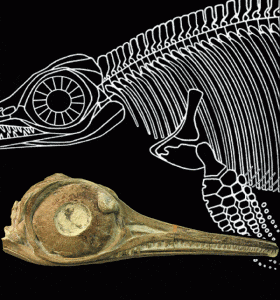 |
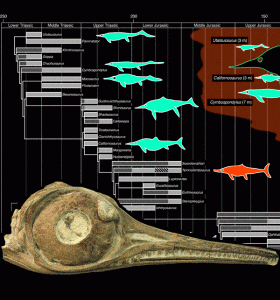 |
download left-hand image here
Caption: Skull (foreground) and skeleton reconstruction (background) of the Jurassic ichthyosaur Hauffiopteryx typicus. Skull photo courtesy of Matt Williams (Bath Royal Literary and Scientific Institution). Skull prepared by Lorie Barber (Bristol City Museum). Skeleton drawing by Bristol MSc Hannah Caine.
download right-hand image here
Caption: Skull of the Jurassic ichthyosaur Hauffiopteryx typicus (foreground) and evolutionary tree of ichthyosaurs (background). Skull photo courtesy of Matt Williams (Bath Royal Literary and Scientific Institution). Skull prepared by Lorie Barber (Bristol City Museum). Evolutionary tree drawing by Professor Mike Benton.

